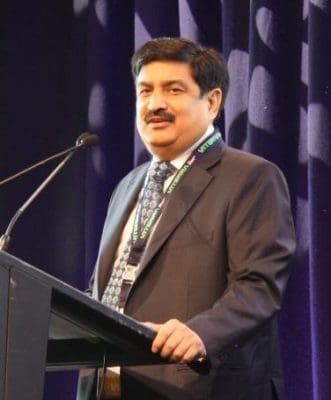
The Pulses 23 desi chickpea panel: Moderator Maulik Maheshwari, Mahahashree Group, Tanzania, AgPulse Analytica principal Gaurav Jain, Sakhi International’s Dileep Kumar, Pakistan, Marina Commodities trader Palwinder Singh, AGT Foods Toowoomba-based senior trader Mitchell Elks, SGR Nepal’s Binod Agarwal and NAFED’s Sunil Kumar Singh.
INDIA’S expanding pulse sector is reshaping the nature of the global chickpea trade as the world’s largest consumer of chickpeas improves its supply chain, a move which could well see it return as an importer in the longer term.
That was the message from National Agricultural Co-operative Marketing Federation of India (NAFED) additional managing director Sunil Kumar Singh, who addressed Pulses 23 yesterday, and then took part in the panel discussion on desi chickpeas.
Mr Singh’s words held no joy for Australian exporters, who lost their biggest market when India placed a tariff on chickpeas after the bulk of Australia’s record 2016-17 crop of 2 million tonnes (Mt) was shipped to Indian ports.
MSP explained
NAFED is the world’s biggest pulse handler, and represents more than 1000 co-operatives.
On behalf of the Indian Government, it undertakes a federal buying program to support prices paid to farmers, and as a buffer against food inflation.
“Through the cooperative structure, we represent millions of farmers who cultivate pulses and oilseeds,” Mr Singh said.
Over a 90-day period, NAFED annually procures five pulses, and in the scheme’s six years to date, Mr Singh said more than 16Mt in total has been bought.
Chickpeas, or gram, have formed the bulk of the volume.
“That’s the cheapest pulse.”
“We have a procurement target of 3.1Mt; we’re up to 2.4Mt now.”

NAFED additional managing director Sunil Kumar Singh shared insights into the Indian Goverment’s MSP program at Pulses 23.
This is on top of stocks held from last season of 1.3-1.4Mt.
Mr Singh said procurement in southern India states has closed now that harvest has ended, but is ongoing in northern regions.
NAFED stocks of all five pulses are sold in three ways: through the open market; to Indian states for processing and sale within their borders, and to the Indian Army.
In 2015-16, India produced 16.38Mt of pulses, and its latest estimate for the current crop year is 27.53Mt.
“There’s a quantum jump of over 11Mt in this six years thanks to the Government of India’s proactive policy.”
Chickpeas have accounted for 64 percent of that increase.
“We have added 7Mt to our chickpea production.”
Big implications for trade
Mr Singh said the MSP for chickpeas is currently 5335 rupees per 100kg versus the market price of 4800R, and chickpeas acquired under the scheme are being sold into the domestic market at 3200-3300R.
“The scheme will run with the discount; the market will not run with the discount,” Mr Singh said on the panel.
The upshot has been that traders holding stocks in India are getting better money by exporting into Australian markets including Bangladesh and the United Arab Emirates.
Australian-based trader Palwinder Singh, Marina Commodities, described UAE as a “very important and stable player in the pulses market”.
“You have seen a significant drop from Australian exporters; they have been replaced by India,” Palwinder Singh said of the UAE market.
AgPulse Analytica principal Gaurav Jain said the Indian market was certainly the one to watch.
“India will depend on selling from NAFED; It is holding large volumes of production,” Mr Jain said.
“India’s price will likely remain below MSP, and Indian exporters will likely be shipping to Bangladesh and the UAE.”
Mr Jain presented figures that put India’s 2023-24 chickpea exports at 245,000t, up from 170,000t in 2022-23.
“We see there will be minimal demand for imports from all destinations.”
With India out of the market, Pakistan has become the world’s volume chickpea importer.
Sakhi International managing director Dileep Kumar said Pakistan has to import at least 450,000t in the current year to supplement domestic production, and around 75-80pc will come from Australia.
“Normally Tanzania is a little bit cheaper; in a normal situation, if Australian is available and Tanzanian is available, we buy Australian and then Tanzanian,” Mr Kumar said.
Mr Jain said Pakistan’s chickpea imports could be as low as 300,000t, and that Ethiopia and Tanzania were exporting more to South Asia and UAE.
“Australia is a better crop than Tanzania; the sub-continent market depends on Australia,” Sunil Kumar Singh told Grain Central after the session.
While demand for Australian chickpeas is low at present, Mr Singh further affirmed the appeal of Australian chickpeas for their quality.
“If Indian demand is robust and it doesn’t have a surplus, you have the market to yourself and it depends on the price,” he said.
SGR principal Binod Agarwal said Nepal was likely to get all its requirements from Australia, while Bangladesh would be buying from more than one origin ahead of Ramadan in 2024.
Mr Agarwal trades in both markets.
“I have burnt all my fingers in Bangladesh,” Mr Agarwal said.
“Bangladesh is a very good market; you have to pay a visit there and meet each and every person.”
He said Nepal was “totally different”.
“They don’t bother about price; they value the relationship; it’s a one-to-one business.
Indian investments ramp up
Sunil Kumar Singh said India’s growing population, income and nutritional need were all driving up its domestic demand, and the MSP program was making pulses more affordable and available, which has encouraged increased production.
“This is an achievement which is very good news for the pulse sector all over the globe.”
“Let me tell you, with this added production, India could continue to import because Indian demand has increased; India’s buying capacity is increasing, India’s nutritional requirement is increasing.
“It’s very good news to the overseas origins.”
He said India’s growth in pulse production was about ensuring its supply chain was not disrupted.
“We are diligently building (it) up with the state support and private-market support.”
Mr Singh said “big investment” was occurring in processing to further encourage chickpea production.
“If we have good milling facilities, the outturn ratio from the raw pulses will be increased; that will increase our availability and reduce the cost.”
He said this was likely to happen in areas where there was “intense production”, including the states of Madhya Pradesh and Rajasthan, and in southern areas too.
“I think this will be an additional incentive for farmers to grow because they’ll be aware that the market is near to them.”
Mr Singh said the Indian Government’s vision for pulses extended to both ends of the supply chain.
“We have duties towards investment in research, seed production, better availability of infrastructure, storage.
“It’s not that we just need to focus on day-to-day trade, but we need to invest in these also so that the entire ecosystem gets a boost.”
He said investment in supplying countries in Africa was also being looked at to help ensure they could out-turn better quality pulses to India.
“If we invest right from ground zero, I’m sure everybody would benefit out of it.”
Mr Singh said NAFED already had relationships with the Global Pulse Confederation and Pulse Canada.
“We look forward to working with Pulse Australia.”
El Niño on radar
Ahead of ABARES releasing its first estimates for 2023-24 production, Mr Jain has forecast the crop now being planted in Australia at 472,000t, down from 599,000t in 2022-23.
“El Niño is a feature which should be talked about,” he said, adding a strong El Niño phase can mean a delayed monsoon season for South Asia and have ramifications for chickpea production beyond Australia.
AGT trader Mitchell Elks believes Australian carry-out from the current season will be close to 100,000t, the lowest in years as the uptick to Pakistan especially has helped to shift volume from the current and previous crops.
“It’s actually relatively tight trying to find desi chickpeas out there now,” Mr Elks said.
In contrast to last year’s late and wet harvest, Mr Elks said the developing crop year could be “a completely different scenario” if rain fails to fall in major production areas of New South Wales and Queensland.
Since the record season of 2016-17, Australian crops have been down sharply, firstly on drought, and then on price.
Last year’s wet harvest caused up to 75pc of the national desi crop to be downgraded to mostly Chickpea M, and on-farm prices had dropped to levels low enough to inspire growers to reduce area.
“CHKPM got almost to A$400/t, which from a farmer point of view is not really a viable crop.”
Prices now at A$500/t are more inspiring for growers looking for a crop to grow in rotation with wheat, but the dry season looks like limiting area.
“There’s a lot of country out there that could be planted if we get rain in the next two weeks.”
Despite its financial difficulties, Pakistan has become the volume buyer of Australian chickpeas.
“Everyone’s found a way to get their product back into Pakistan.”
“We’ve got quite a lot of product pointed towards Pakistan at the moment in containers and vessels.”
“Pakistan and the weather are the only two things you need to look at when you wake up in the morning.”
Consensus on price for coming months sits at around US$500-$550/t c&f into South Asia and the UAE, and that values above that can lead to significant trading losses in the Pakistani domestic market.



Promote cultivation of chickpea and other indigenous pulses that are power house of nutrients, both macro and micronutrients. Amino acids composition of Chickpea is comparable to that of soybean and therefore deserves to be considered as a source of complete protein.